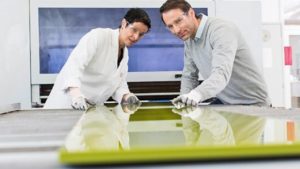What is ‘Fusion Coating’?
Developed by company Henkel, the ‘Fusion Coating’ process is a surface coating concept for the decorative treatment of melamine faced panels. In ‘Fusion Coating’ an UV-curing hotmelt (Technomelt CHS 370 UV) is applied directly to the melamine faced panels where it acts as a primer for one or several further coats of lacquer that create the desired high-gloss effect. Due to its good adhesion on melamine and compatibility with UV lacquers matched to the system, this hotmelt provides the basis for the creation of high-gloss finishes.

The hotmelt is roller-applied. The working temperature lies between just 90°C and 100°C. According to the company, cost savings can be achieved due to the fact that the UV hotmelt cures immediately, allowing the workpiece to move directly to the next process. Technomelt CHS 370 UV is also free from volatile organic compounds (VOC).
Traditional technologies for generating high-gloss effects include applying a high-gloss film laminate to wood based panels. However, this process is considered as cost-intensive. And the use of paints and varnishes on melamine faced panels is also problematic because the primers used usually offer poor adhesion on melamine and are not as flexible as a UV-curing hotmelt.
